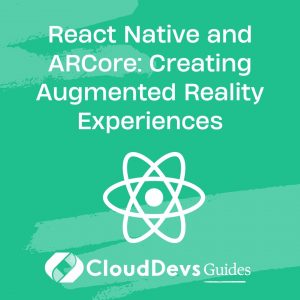React Native and ARCore: Creating Augmented Reality Experiences
In the realm of mobile app development, React Native has emerged as a game-changer, allowing developers to build cross-platform applications with ease. But what happens when you merge the power of React Native with Google’s ARCore? You unlock the potential to create immersive augmented reality (AR) experiences that blur the lines between the digital and physical worlds. In this article, we’ll delve into how React Native and ARCore can be combined to craft captivating AR experiences, along with some inspiring examples to spark your creativity.
Understanding React Native and ARCore
React Native:
React Native, developed by Facebook, is a popular JavaScript framework for building native mobile applications. It allows developers to write code once and deploy it across multiple platforms, including iOS and Android, saving time and resources in the development process.
ARCore:
ARCore, Google’s platform for building AR experiences on Android devices, provides developers with tools to integrate digital content seamlessly into the real world. It enables features like motion tracking, environmental understanding, and light estimation to create immersive AR applications.
Integrating React Native with ARCore
Thanks to community efforts and third-party libraries, integrating React Native with ARCore has become feasible. One such library is react-native-arkit, which bridges the gap between React Native and ARKit/ARCore, allowing developers to create AR experiences using familiar React Native components.
Example Projects:
1. Furniture Shopping App:
Imagine an app where users can visualize furniture pieces in their own living spaces before making a purchase. By leveraging React Native and ARCore, developers can create an immersive shopping experience where users can place virtual furniture items in their rooms, adjust their position, size, and even see how they complement the existing decor.
2. Educational Tools:
AR has tremendous potential in education. With React Native and ARCore, developers can build interactive learning tools that bring educational content to life. For instance, students studying anatomy could use an AR app to explore 3D models of the human body, zooming in to see detailed structures and gaining a deeper understanding of complex concepts.
3. Tourism Guide:
Tourism apps can leverage AR to enhance the travel experience. By combining React Native with ARCore, developers can create guides that overlay information, historical facts, and points of interest onto real-world locations. Travelers can use their smartphones to explore cities, uncover hidden gems, and learn about landmarks in an engaging and interactive way.
Conclusion:
The fusion of React Native and ARCore opens up a world of possibilities for developers looking to create immersive and engaging AR experiences. Whether it’s enhancing e-commerce, revolutionizing education, or reimagining tourism, the combination of these technologies empowers developers to push the boundaries of mobile app innovation. So, roll up your sleeves, dive into the world of React Native and ARCore, and unleash your creativity to craft AR experiences that captivate and inspire.
Ready to get started? Check out the example projects above and begin your journey into the exciting realm of React Native augmented reality.
Remember, the only limit is your imagination.
External Links:
Table of Contents









